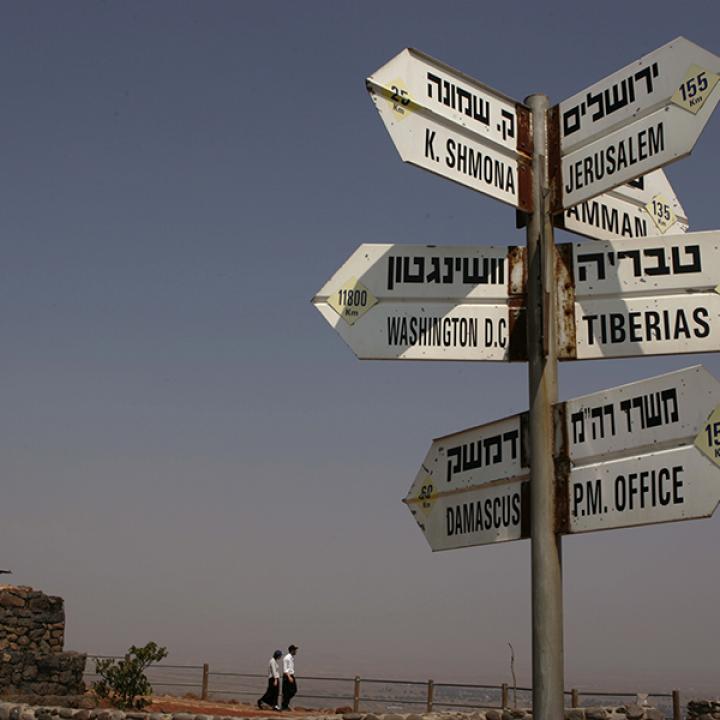
- Policy Analysis
- Policy Alert
Iran’s Miscalculated Escalation in the Golan

The latest clash indicates that Tehran has underestimated how far the IDF will go to prevent Iranian military entrenchment on its northeast border.
In the early hours of May 10, about thirty projectiles were fired from Syrian soil at forward Israeli military positions along the occupied Golan Heights. Described by the Israel Defense Forces as Iranian Grad and Fajr-5 rockets, all but four of the weapons reportedly landed harmlessly in Syria, while the remainder were intercepted by Israeli Iron Dome systems.
In response, the IDF quickly launched standoff air and missile strikes against sixty Iranian military intelligence facilities, logistical targets, and military compounds in Syria, including an Islamic Revolutionary Guard Corps-Qods Force weapons depot at Damascus airport. Active Syrian air defense positions were targeted as well. According to Russian military sources, Israel fired sixty air-to-surface missiles and ten surface-to-surface missiles.
IDF sources say the attack was ordered by Qods Force commander Qasem Soleimani. Although it is unknown if Iran notified Damascus in advance, Syrian military sources quickly claimed that their own forces were behind the operation, and parliamentary speaker Hammouda Sabbagh called it the beginning of a new era in Syria’s struggle against its enemies.
Syrian and Iranian sources also indicated that the rocket salvos mainly targeted Israeli intelligence and command facilities in the Golan Heights, including electronic jamming positions and surveillance posts belonging to the IDF’s secretive Unit 9900. Likewise, Israel’s retaliatory strikes included targets related to Iranian and Syrian intelligence activities.
Among the systems used in the original attack was the Grad, a truck-mounted, 122 mm multiple-launch rocket system with a range of 20 km. Yet Iranian forces and their proxies also have longer-range Fajr rockets that can be fired from much further back. A 224 mm Fajr-3 has a range of 45 km and can reach Israeli positions in northern Golan from the southern suburbs of Damascus. Some local photos confirmed the use of larger 333 mm Fajr-5 rockets with a range of 75 km, meaning they can reach southern Golan from as far away as Suwayda province and the nearby al-Thaala air base. According to independent Syrian media sources (e.g., see here and here), Israel’s retaliatory operations struck at least twenty-four targets in Suwayda alone, including radar and air defense positions.
As for why the original attack was launched in the first place, the perpetrators may have intended it as a proportional response to Israel’s April 9 strike on Iran’s drone facilities at the T-4 (Tiyas) air base and its later strikes against air defense assets. By limiting the attack’s scope, they may have sought to avoid uncontrollable escalation, perhaps not expecting such extensive IDF retaliation. The apparent decision not to employ more accurate and powerful missiles such as the Fateh would seem to support this idea (assuming such weapons were still available to forces in Syria following Israel’s previous raids). This conclusion might change if Iran is found to have used any of its more advanced Fajr variants, including guided and cluster-warhead versions. So far, though, Tehran’s official response has been silence, implying a desire to avoid further hostilities for now.
Yet the possibility of escalation cannot be entirely dismissed, especially since other hostile actors have been issuing threats in the wake of Israel’s strikes. For example, the Gaza-based Palestinian militant group the Popular Resistance Committees declared that “any Zionist military reaction will face operations stronger and heavier in the depth of Zionism,” implying attacks inside Israel proper. And by attempting to take credit for the rocket attack, the Syrian regime may seek to bolster its legitimacy in Arab public opinion via direct struggle with “the Zionist enemy.”
Even so, if what Iranian sources say is true—that the main objective of the rocket strike was to deter Israel and weaken the impact of the IDF’s own deterrent efforts—then subsequent events show it has failed. The IDF responded quickly and disproportionally by attacking “almost all Iranian-operated facilities in Syria,” according to Defense Minister Avigdor Liberman. This response may well affect the future calculations of Iran and its allies as they decide their next move. If the Israeli strikes were as effective as some have indicated, and if the resultant casualties were low enough to keep Tehran from feeling obligated to retaliate, then a temporary calm may unfold over the coming weeks.
In the broader picture, by repeatedly acting to preempt aggressive Iranian military movements in Syria, Israel has shown its determination to prevent the Qods Force from entrenching itself on the northeast frontier and launching a Gaza-style attrition campaign that could eventually be handed over to a Syrian version of Hezbollah.
Farzin Nadimi is an associate fellow with The Washington Institute, specializing in the security and defense affairs of Iran and the Persian Gulf region.



